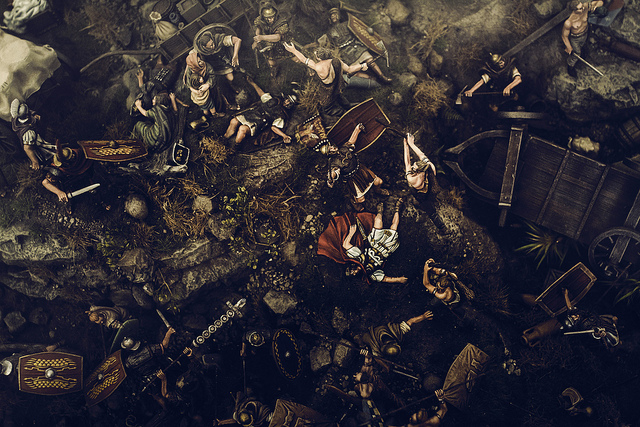Europe has never been short of war. Good war has always been just round the corner on the second continent to bear civilization. Let us remember the Strange Name Wars in early Rome, when angry males with splashy noms de guerre like Hostus Hostilius and Titus Tatius (even then great warriors knew they would not make headway with a name like Ivan Ivanov) fought valiantly over the right to establish an order that will allow them to rage more war. Following a couple of centuries of strife, it apparead that Europe was finally ready to call it quits and settle. But in the year 2017 of our Lord out of the shadows came forward an ancient evil that threatened the foundations of Europe’s success as a democracy: kebab. War was once again on the menu to defend Europe and its most coveted secret.
Origins of war in Europe

Be it large empire-led conquest or everyday feud between petty vassals in the countryside, by the time the mixture of politically-harnessed religion and staggering illiteracy raised the stakes in the Middle Ages war had settled in Europe’s everyday life, becoming as common as washing your teeth. Naturally, given the primitive state of tactics and weaponry, the actual casualties were low; something Europeans set to change in the centuries following the Reformation.War on the continent was initially a raw affair fought over simple utilitarian concerns. Many people were convinced they would take better care of their neighbours’ property, and since the latter would not often concede ownership voluntarily it sometimes had to be transferred by force. Since Europe was young and corporation-free, there were plenty of assets to be distributed among an increasing number of competitors. Having learned about the first-class mineral springs mud-crusted tribes from as far back as the Far East came to the continent to bathe. In doing so, they disturbed the peace of belligerent locals who were reluctant to grant entry to new contenders, barbarians in particular. Of course, the incumbents were no less clueless, but they at least could convincingly cast human bodies in stone.
Instead of leading to a more balanced social equilibrium, newly discovered knowledge during the age of Enlightenment added more colour and fervency to military campaigns. In the same time, Europe, previously mostly a net receiver of invaders, commenced ravaging other continents, with the distribution of this new wealth also becoming a cause of major internal strife. A process that culminated in Europe’s biggest achievement – staging two continent-wide wars in the curse of only four decades and embroiling places as far away as the East Indies in them.
Be it large empire-led conquest or everyday feud between petty vassals in the countryside, by the time the mixture of politically-harnessed religion and staggering illiteracy raised the stakes in the Middle Ages war had settled in Europe’s everyday life, becoming as common as washing your teeth.

Modern European warfare: defending kebab
Much changed for war in Europe in the second half of the 20th century. Although the continent’s potential for old-school war was not completely exhausted, military conflict was outsourced to loser countries, giving way to new players and new types of warfare back home. States, hitherto chief warmongers, were supplanted by corporations boasting bigger budgets and better management. Weapons also packed a hefty punch and their actual use on a daily basis became impractical, with superpowers being content to install a red button on their cabinet desk and brag about it. World leaders realized they do not need to obliterate the enemy, as they would become quite lonely. They merely had to destroy one’s reputation, which was a piece of cake as masses in Europe were still pestered by an astounding lack of awareness, despite centuries of reason and education. In addition, progressively shadier and divisive ideologies had replaced religion, which, dressed as exquisite propaganda, could now reach any consumer in seconds.
On the surface, the 2017 kebab war caught Europe at a quiet moment – the Global Peace Index, a very reliable source, had just declared Europe the most peaceful region on Earth, being home to seven of ten most peaceful countries worldwide, or at least this side of the Shire. It seemed that old ghosts had finally left the continent in search of new soil across the Atlantic. That Europe was finally ready to shed its troubled past and flourish as a community of simple folk, finding pleasure in the little joys of life, such as singing hallelujah in the sun and smoking leaf. But deep down East something was brewing, an ancient evil was lurking in the shadows, threatening the very foundation of Europe’s newfound peace: kebab. Jolted out of their oblivion, Europeans were forced to hold weapons once again to defend their ways.
Kebab was an essential element of what made Europe the birthplace of democracy. A primordial force cultivated by Europeans in foreign lands and brought back to the continent to nurture meat-eaters for battle against the tyranny of illiberal regimes.
For kebab was not just roasted meat on a rolling skewer. Nor it was simply an adhesive for social cohesion, providing respite from the evils of neo-liberal life to European commoners irrespective of rank and gender. Kebab was an essential element of what made Europe the birthplace of democracy. A primordial force cultivated by Europeans in foreign lands and brought back to the continent to nurture meat-eaters for battle against the tyranny of illiberal regimes. From mouth to mouth and battle to battle kebab had become part and parcel of the continent’s advent as a beacon of the rule of law.

Kebab war: background and outcome

Knowledge regarding kebab’s provenance is mired in legend. Barbarians in borderline cultures certainly knew about its might, since slaying lamb as a gift to the Gods was popular in a few pagan cults, substituting initial cannibalistic practices. The regenerative power of roasted kebab meat was harnessed to conquer emaciated kingdoms, where locals only fed on cereal. The esoteric qualities of skewer fruit were eventually codified in secret texts to be discovered by hungry European conquistadors, some of which were transferred to Europe and survived the toilet paper crisis of the 1600s. Henceforth, it was Europe where kebab finally clicked, giving rise to the social revolutions that led to basic civil rights.
The esoteric qualities of skewer fruit were eventually codified in secret texts to be discovered by hungry European conquistadors, some of which were transferred to Europe and survived the toilet paper crisis of the 1600s
Consequently, finding a way to besmirch the power of kebab became the main goal of enemies prowling at Europe’s Eastern borders. Secret societies as old as Hooddhists came forward preaching against meat, claiming that eating dead carcasses had unexpected side effects, among which indigestion and hatred. If accumulated, they argued, this could lead to military conflict. Such vile propaganda was obviously directed at discrediting European states, whose success was mostly based on conquest and resource extraction. The baton was then passed in the 20th century to commies, who put in place an entire disinformation machine that positioned kebab against family values. It was this foul magic that their herbivorous descendants in European Parliament utilized to lay waste on kebab over health concerns. It seemed dark forces once again conspired to discredit kebab and shake the foundations of Europe.

This is when a valiant volk from the North-West, a returned superpower, stood against the menace, sparing no resources to protect Europe’s only treasure and make sure evil is defeated once and for all. The ensuing battle was fierce – over 230,000 workers and billions of shekels were cornered by an army of environmentalists with sharp accusations of questionable treatment of frozen meat. Only when Christian conservatives, a once forgotten breed of elite political assassins were employed, old Europe, Europe of traditions and healthy morals, finally won.
This is also how this tale ends. The status quo was maintained by the brave and mighty of the day.
Cover photo: Source: Garret Voight (Flickr); Licence: CC BY-NC 2.0










